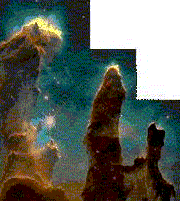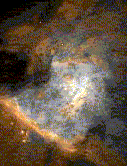 |
||
| First page | ||
 |
||
| Birth | ||
 |
||
| Main Sequence | ||
 |
||
| White Dwarf | ||
 |
||
| Red giant | ||
 |
||
| Supernova | ||
 |
Death | |
 |
||
 |
||
The formation of stars is still a mystery in many ways because we don't know why a single large cloud fragments and form individual stars or why multiple-star systems or planets form. However, we do know how it is likely to be.

We know that stars are made of gas, and we want to know where we can find plenty of the raw material required. So the prime places to look must be giant molecular clouds since they have a low temperature and high density.
It takes a long time for a star, as we see it, to be born. While a condensation of matter in a molecular cloud is contracting to become a true star it is called a protostar. Before becoming a "real" star the so called protostar spends some thousand or even million years in a contraction and heating phase. Movements in a molecular cloud makes dust and matter form a ball with high density.
To attract even more matter the dense core of material uses its gravity force, and a protostar is born. A star first becomes visible only after the stellar wind, mainly consisting of protons streaming away from the star, clears away the surrounding dust and gas and leaves a rotating disk.

The convection currents cease at the centre of the protostar and energy must be transported by radiation in those regions. Slowly, the protostar starts moving toward the Main Sequence.
The story of stellar evolution is the story of the competition between two forces; gravity and pressure. When those two forces are in balance the star is stable. What happens is that gravity tries to make a star collapse and internal pressure, caused by the motions of the gas atoms, tries to force the star to expand.
Now that we know how a star form, we can use the Hertzsprung-Russell (H-R) diagram to summarize how they evolve.
23 August 2000
Sarah Amandusson
www_astro@mssl.ucl.ac.uk